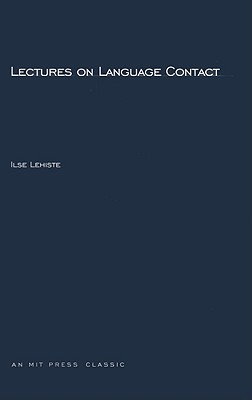
- We will send in 10–14 business days.
- Author: Ilse Lehiste
- Publisher: MIT Press
- ISBN-10: 0262620618
- ISBN-13: 9780262620611
- Format: 13.5 x 19.8 x 0.8 cm, softcover
- Language: English
- SAVE -10% with code: EXTRA
Reviews
Description
These concise lectures have been developed and refined over a period of ten years as the basis for the author's senior and first-year graduate course on language contact. They provide factual information on and interpretations of a topic of obvious sociolinguistic importance; Lehiste's more formal linguistic approach (reflected in the emphasis on the experimental testing of theories) offers the student a firm background to which sociological and anthropological data can be added through collateral reading. The book summarizes a large literature in a quick, thorough way and adds a useful glossary and rich bibliography. Among the topics covered are the concept of interference, bilingualism, language convergence, and pidgins and creoles. The examples are drawn from European sources (reflecting the author's own work), but references are given to other areas.Useful as a condensed survey of existing information, and incorporating the author's own research, the text covers the major aspects of language contact, including the concept of linguistic affinity (Sprachbund); language contact as a cause of linguistic change; results of language contact; methods of comparing linguistic structures; concepts of linguistic convergence and linguistic interference; comparisons of the language usages of monolingual speakers with those of bilingual and multilingual speakers; and separate treatments of the bilingual individual and the bilingual community. Social aspects of the contact situation - with illustrative case histories - are described and analyzed.
EXTRA 10 % discount with code: EXTRA
The promotion ends in 16d.17:45:08
The discount code is valid when purchasing from 10 €. Discounts do not stack.
- Author: Ilse Lehiste
- Publisher: MIT Press
- ISBN-10: 0262620618
- ISBN-13: 9780262620611
- Format: 13.5 x 19.8 x 0.8 cm, softcover
- Language: English English
These concise lectures have been developed and refined over a period of ten years as the basis for the author's senior and first-year graduate course on language contact. They provide factual information on and interpretations of a topic of obvious sociolinguistic importance; Lehiste's more formal linguistic approach (reflected in the emphasis on the experimental testing of theories) offers the student a firm background to which sociological and anthropological data can be added through collateral reading. The book summarizes a large literature in a quick, thorough way and adds a useful glossary and rich bibliography. Among the topics covered are the concept of interference, bilingualism, language convergence, and pidgins and creoles. The examples are drawn from European sources (reflecting the author's own work), but references are given to other areas.Useful as a condensed survey of existing information, and incorporating the author's own research, the text covers the major aspects of language contact, including the concept of linguistic affinity (Sprachbund); language contact as a cause of linguistic change; results of language contact; methods of comparing linguistic structures; concepts of linguistic convergence and linguistic interference; comparisons of the language usages of monolingual speakers with those of bilingual and multilingual speakers; and separate treatments of the bilingual individual and the bilingual community. Social aspects of the contact situation - with illustrative case histories - are described and analyzed.


Reviews